
The efficient performance of first-aid measures should be well perfected by people in general and by family members and spouses of the expectant mother in particular, as the ultimate goal is protecting a pregnant woman and her fetus. The first task of this attention is to formulate relevant and practical recommendations that one may need during first-aid practice due to a woman choking out her baby or a baby choking on a pregnant woman. This task seeks to inform practitioners of the signs of choking in pregnant women and safe methods of administering Heimlich's maneuver. Specific techniques have been known to be reliable, but their safety should be of concern: what are the recommended handling techniques, risk factors, and causes? We will consider how actions are directed to remove such a child's risk so that no harm is done to the mother. When you are through this article, be sure you won't have any difficulties when facing or giving first aid to a woman in such a condition.
 It is important to note and recognize the first response signs of choking among pregnant women. The first warning is the inability to utter, cough, or breathe properly. You might see her hands covering her neck since it is a universal sign of aspiration. There could also be wheezing, stridor sounds, cyanosis of the lips or skin owing to hypoxia, and panicky or agitated movements. In extreme instances, if the obstruction is not immediately removed, she may become unconscious. Responding quickly to avoid additional consequences when these indicators are spotted is crucial.
It is important to note and recognize the first response signs of choking among pregnant women. The first warning is the inability to utter, cough, or breathe properly. You might see her hands covering her neck since it is a universal sign of aspiration. There could also be wheezing, stridor sounds, cyanosis of the lips or skin owing to hypoxia, and panicky or agitated movements. In extreme instances, if the obstruction is not immediately removed, she may become unconscious. Responding quickly to avoid additional consequences when these indicators are spotted is crucial.
 In the case of a pregnant woman who is choking and needs immediate intervention, you do the following procedures: First of all, remember that it is essential to call for emergency medical assistance when a person starts choking. Regular abdominal thrusts should be avoided as anatomical changes in mechanics make them less effective; instead, chest thrusts should be used. Now, standing behind the woman, reach around her body with both your arms, under her arms, and around her chest. One hand should be in a fist, its thumb facing the center of the woman’s chest where the rib cage meets, about 2 inches above the level of the stone at the base of her abdomen. Hold your fist with the other hand and make sharp thrusts in a quick in-and-up motion. These steps should be repeated unless the object has been removed or someone comes to assist you. Ensure that you keep her in your line of sight and be prepared if need to administer CPR with the use of spaces if she becomes ‘out’; observe what touching spaces adds to a larger body, that this adjusted practice makes for one having to worry about better the pregnant woman’s body.
In the case of a pregnant woman who is choking and needs immediate intervention, you do the following procedures: First of all, remember that it is essential to call for emergency medical assistance when a person starts choking. Regular abdominal thrusts should be avoided as anatomical changes in mechanics make them less effective; instead, chest thrusts should be used. Now, standing behind the woman, reach around her body with both your arms, under her arms, and around her chest. One hand should be in a fist, its thumb facing the center of the woman’s chest where the rib cage meets, about 2 inches above the level of the stone at the base of her abdomen. Hold your fist with the other hand and make sharp thrusts in a quick in-and-up motion. These steps should be repeated unless the object has been removed or someone comes to assist you. Ensure that you keep her in your line of sight and be prepared if need to administer CPR with the use of spaces if she becomes ‘out’; observe what touching spaces adds to a larger body, that this adjusted practice makes for one having to worry about better the pregnant woman’s body.
 If the woman in labor is unresponsive, urgent intervention is needed. The first step is to contact relevant authorities as soon as possible or to ask an onlooker to do so. CPR should be performed right away. The woman in question should be flat on her back, with the chest being the area focused on, and steady pressure should be applied to it; start beating at the center of the chest. This involves no more than a hard push down and up on the chest until it is fully pushed in and released. In case of absence of an emergency and if someone is appropriately trained, administer finger breathing in a 30 to 2 ratio. Keep performing CPR until help arrives or until the lady starts breathing. It should be noted, however, that timely action can significantly benefit the outcome.
If the woman in labor is unresponsive, urgent intervention is needed. The first step is to contact relevant authorities as soon as possible or to ask an onlooker to do so. CPR should be performed right away. The woman in question should be flat on her back, with the chest being the area focused on, and steady pressure should be applied to it; start beating at the center of the chest. This involves no more than a hard push down and up on the chest until it is fully pushed in and released. In case of absence of an emergency and if someone is appropriately trained, administer finger breathing in a 30 to 2 ratio. Keep performing CPR until help arrives or until the lady starts breathing. It should be noted, however, that timely action can significantly benefit the outcome.
 Before assistance arrives, wait for the professional circling of trained personnel, where you first check to see if it also poses a danger to the victim and you. Check to see if there are conditions that can allow for the person to breathe. If the victim is unconscious but has some breath, lay him down on his side to channel the breath through the nose. In a situation when the person does not breathe, hands, legs, and chest stall start CPR at once with a later stage engaging in rescue breaths and chest motions where possible. As soon as it is practicable, have the defibrillation operation performed. In any case, don’t lose your composure; if the patient is awake, you can soothe him/her and tell him/her everything will be alright. Be attentive to their condition in case the emergency services arrive and explain and describe the affairs.
Before assistance arrives, wait for the professional circling of trained personnel, where you first check to see if it also poses a danger to the victim and you. Check to see if there are conditions that can allow for the person to breathe. If the victim is unconscious but has some breath, lay him down on his side to channel the breath through the nose. In a situation when the person does not breathe, hands, legs, and chest stall start CPR at once with a later stage engaging in rescue breaths and chest motions where possible. As soon as it is practicable, have the defibrillation operation performed. In any case, don’t lose your composure; if the patient is awake, you can soothe him/her and tell him/her everything will be alright. Be attentive to their condition in case the emergency services arrive and explain and describe the affairs.
What are the Signs of a Pregnant Woman Choking?
 It is important to note and recognize the first response signs of choking among pregnant women. The first warning is the inability to utter, cough, or breathe properly. You might see her hands covering her neck since it is a universal sign of aspiration. There could also be wheezing, stridor sounds, cyanosis of the lips or skin owing to hypoxia, and panicky or agitated movements. In extreme instances, if the obstruction is not immediately removed, she may become unconscious. Responding quickly to avoid additional consequences when these indicators are spotted is crucial.
It is important to note and recognize the first response signs of choking among pregnant women. The first warning is the inability to utter, cough, or breathe properly. You might see her hands covering her neck since it is a universal sign of aspiration. There could also be wheezing, stridor sounds, cyanosis of the lips or skin owing to hypoxia, and panicky or agitated movements. In extreme instances, if the obstruction is not immediately removed, she may become unconscious. Responding quickly to avoid additional consequences when these indicators are spotted is crucial.
Recognizing Airway Obstruction
In the case of pregnant women, recognizing an obstructed airway involves distinguishing a partial obstruction from a complete obstruction. Partial airway obstruction could appear as wheezing, a cough, or difficulty in talking, whereas, with complete obstruction, the patient is said to be unable to speak, breathe, or cough. Action must be taken immediately because devoid of oxygen for a short time will have adverse effects. Pregnant women may, among other things, have heightened anxiety or show facial distress. Because of the effects of pregnancy with factors such as increased abdominal bulge and changes in the shape of the chest cavity, the field of management of choking has to deviate from conventional first aid practices. Composure must be exercised with speed and urgency to help the person in the choking scenario.Understanding the Differences in Symptoms
As I analyze how the symptoms related to airway obstruction in pregnant patients vary, two things become apparent: partial and complete obstructions all come with their own fair set of difficulties. I’ve understood that partial obstruction leads to some airway slack that causes wheezing and labored breathing. In contrast, complete obstruction does not allow any passable air out of the lungs, hence no voice, breath, or cough. Body movements such as holding and grasping the neck or changing color to a bluish hue give clues of pending danger. I have come to appreciate that timely modification of the focus in such circumstances is very useful because a pregnant woman's physical configuration differs from that of the rest of the population. Thus, first aid measures for choking may vary quite a bit. These subtleties make me feel useful, knowing that they enable me to perform better when such situations present themselves.When to Call for Emergency Help
Understanding when to summon help while dealing with an upper airway obstruction is essential. Seek assistance immediately if you notice complete airway obstruction when someone cannot talk, breathe, or cough. In addition, note any cyanosis of the skin or lips or beds of the fingernails, which might indicate inadequate oxygenation of the patient. It is also essential to call an ambulance in case the pregnant woman is grossly anxious or appears very distressed. This is critical since a delay in treatment may lead to severe complications for both the mother and the fetus. It is important to describe to the medical professionals if there are any pregnancy complications so that they can promptly provide appropriate management.
How to Provide Immediate First Aid to a Choking Pregnant Woman?
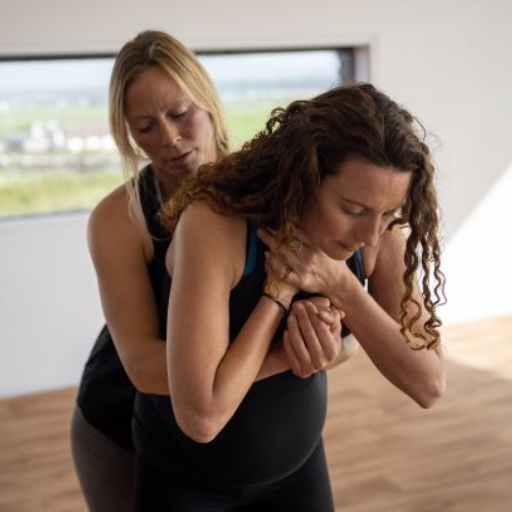 In the case of a pregnant woman who is choking and needs immediate intervention, you do the following procedures: First of all, remember that it is essential to call for emergency medical assistance when a person starts choking. Regular abdominal thrusts should be avoided as anatomical changes in mechanics make them less effective; instead, chest thrusts should be used. Now, standing behind the woman, reach around her body with both your arms, under her arms, and around her chest. One hand should be in a fist, its thumb facing the center of the woman’s chest where the rib cage meets, about 2 inches above the level of the stone at the base of her abdomen. Hold your fist with the other hand and make sharp thrusts in a quick in-and-up motion. These steps should be repeated unless the object has been removed or someone comes to assist you. Ensure that you keep her in your line of sight and be prepared if need to administer CPR with the use of spaces if she becomes ‘out’; observe what touching spaces adds to a larger body, that this adjusted practice makes for one having to worry about better the pregnant woman’s body.
In the case of a pregnant woman who is choking and needs immediate intervention, you do the following procedures: First of all, remember that it is essential to call for emergency medical assistance when a person starts choking. Regular abdominal thrusts should be avoided as anatomical changes in mechanics make them less effective; instead, chest thrusts should be used. Now, standing behind the woman, reach around her body with both your arms, under her arms, and around her chest. One hand should be in a fist, its thumb facing the center of the woman’s chest where the rib cage meets, about 2 inches above the level of the stone at the base of her abdomen. Hold your fist with the other hand and make sharp thrusts in a quick in-and-up motion. These steps should be repeated unless the object has been removed or someone comes to assist you. Ensure that you keep her in your line of sight and be prepared if need to administer CPR with the use of spaces if she becomes ‘out’; observe what touching spaces adds to a larger body, that this adjusted practice makes for one having to worry about better the pregnant woman’s body.
Modified Heimlich Maneuver: Chest Thrust Technique
For a pregnant woman who is in the middle of choking, it is best to refrain from applying the standard abdominal thrusts because of the risks posed to the developing fetus. In its place, the chest thrust technique is more secure and specially modified for pregnant women. Position yourself behind the woman, bend your arms down, and encircle the lady’s upper chest with your arms. Place your fist so your thumb side points to the middle of her chest, just below her sternum and well above her navel. With the other hand grasping the fist, perform several brief, sharp upward thrusts into the chest with both hands, squeezing your palm into the thumb side. Continue these thrusts until the choking obstruction is cleared or professionals take over the assistance. This method observes the anatomical changes that occur in the body during pregnancy to protect the health of both the mother and the child. If the woman is unconscious, start CPR on her while calling for an emergency service. This way, you will not get confused about what to do in such dire circumstances.Why Abdominal Thrusts are Not Recommended?
For pregnant women, abdominal thrusts are contraindicated due to possible damage to the fetus and the changes in the mother's body structure. Abdominal thrusts are said to predictably exert pressure on the abdomen that can injure the fetus or the uterus. Per the guidelines set forth by the American Red Cross and other reputable institutions, shifting to chest thrust is more beneficial because it reduces foci of direct pressures over the abdomen instead of the uterus. The same goes for anatomical changes, like those caused by the dislocation of essential organs during pregnancy.
Steps for Delivering Back Blows
When delivering back blows to a pregnant woman who is choking, follow these steps to ensure her safety and efficacy of the intervention:
- Position the Woman: Stand to the side or slightly behind the woman, ensuring she is stable and can lean forward comfortably.
- Support the Chest: Use one arm to support her chest. This enables her to lean forward and allows gravity to help dislodge the object.
- Locate the Shoulder Blades: Aim for the area between her shoulder blades with the heel of your other hand.
- Deliver Firm Blows: Administer up to five firm back blows. The force should be sufficient to dislodge the obstruction but controlled to prevent injury. Make sure the blows are in an upward motion.
- Check for Obstruction Removal: Check if the object is dislodged after each blow. If the obstruction persists, prepare to perform chest thrusts and call for emergency assistance if not previously done.
Following these steps effectively coordinates the safety considerations for a pregnant woman while maximizing the chances of removing the choking obstruction. Always remember to seek professional help if the situation does not resolve promptly.
What to Do If the Choking Pregnant Woman Becomes Unresponsive?
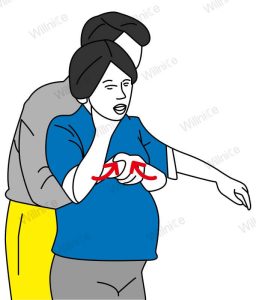 If the woman in labor is unresponsive, urgent intervention is needed. The first step is to contact relevant authorities as soon as possible or to ask an onlooker to do so. CPR should be performed right away. The woman in question should be flat on her back, with the chest being the area focused on, and steady pressure should be applied to it; start beating at the center of the chest. This involves no more than a hard push down and up on the chest until it is fully pushed in and released. In case of absence of an emergency and if someone is appropriately trained, administer finger breathing in a 30 to 2 ratio. Keep performing CPR until help arrives or until the lady starts breathing. It should be noted, however, that timely action can significantly benefit the outcome.
If the woman in labor is unresponsive, urgent intervention is needed. The first step is to contact relevant authorities as soon as possible or to ask an onlooker to do so. CPR should be performed right away. The woman in question should be flat on her back, with the chest being the area focused on, and steady pressure should be applied to it; start beating at the center of the chest. This involves no more than a hard push down and up on the chest until it is fully pushed in and released. In case of absence of an emergency and if someone is appropriately trained, administer finger breathing in a 30 to 2 ratio. Keep performing CPR until help arrives or until the lady starts breathing. It should be noted, however, that timely action can significantly benefit the outcome.
Initiating CPR for Pregnant Women
In the case of pregnant women and CPR, specific measures need to be taken to minimize the adverse effects while ensuring the objective of resuscitation is achieved. First, the woman in labor must lie on her back mildly turned to the left side, putting a rolled towel or wedged at the right hip. This position helps avoid compression of the major blood vessels by the uterus, which may interfere with circulation. Begin with chest compressions focused in the middle of the breastbone at a depth of 2 inches (5 cm) and a frequency of between 100 and 120 compressions per minute. If qualified, provide rescue breaths after every thirty compressions, each taking about one second to administer, enabling visibility of the chest rising. Until the arrival of emergency services or the woman is alert again, performing C-P-R should be persistent and practical. When available, follow the directions for the AED, adjusting pad positions as necessary for belly size. If they arrive swiftly and know what to do, marked results can be achieved for both mother and child. Always obtain further instructions from healthcare workers and adhere to current CPR protocols.How to Perform Chest Compressions Safely?
To do chest compressions safely, I first make sure that the person is lying on a flat and solid surface. I stand beside the patient and place the heel of my left palm on the lower part of the patient’s chest in the middle. I then place the other palm on my left palm and interlock my fingers. Sitting with elbows straight, I put my weight on my hands and adjust my shoulders right above the wrist, bearing my weight to do chest compressions at the recommended rate of about 100-120 compressions per minute using an average depth of at least two inches in total for the adult population. Once again, as long as the process is appropriate and suitable, I always let it rest completely to allow optimal blood flow during pauses in chest compression. The preferred technique ultimately enables the chest to expand after each compression. During compressions, trained people ensure rescue breaths are offered after every 30 compressions, maintaining each breath to 1 second. During the entire procedure, however, I observe any response changes and hold the hand's position until help is received or until they recover.When to Use an AED
Automated External Defibrillator (AED) should be brought into play at the earliest once a person has collapsed and seems to be suffering from abrupt cardiac arrest. Such indications include the individual being unconscious, showing no signs of breathing, or having no pulse. An AED should be used as soon as possible because it improves a person’s likelihood of survival by normalizing their heart rhythm. The system is simple to use because it provides speech instruction and visual cues that make it easy to operate regardless of level of training. When using an AED, place the pads on the bare chest of the victim. Place one pad on the top right portion of the chest and the other on the bottom left portion. Most AEDs recommend delivering a shock if appropriate, and the device walks the rescuer through each step. It is advisable to continue CPR between shocks, if recommended, at compressions of 100 to 120 per minute at a depth of beating of at least 2 inches for adults until emergency medical services arrive. Always use the AED as directed in the manual.
How to Prepare for a Choking Emergency?
Understanding the procedures and skills needed when preparing for and dealing with a choking emergency is essential. In case a person is choking, it is necessary to look for signs that include the person not being able to cough, speak, or breathe even a little. Maintain calmness and seek emergency medical services if needed. First, have the person cough to try and get rid of the object on his or her own. If this does not work, stand behind the individual and, with their navel at your fist, perform thrusts thanking them, ‘Heimlich,’ thrust your fist in going in and up. Continue using this technique until the foreign body is expelled or the victim becomes unresponsive, in which case CPR may become necessary. To avoid putting yourself in these situations, one has to make the place accessible from the possibility of choking in the first place and instruct others on these techniques that may help deal with choking.Taking a First Aid Course
A first aid course is significant because it helps individuals gain essential skills for dealing with medical emergencies. Most such courses include CPR and the Heimlich maneuver, how to dress a wound, and how to use an Automated External Defibrillator (AED), amongst other skills. The trainees are trained to be able to escape and tend a patient while caring for the patient while waiting for professionals. In addition, the first aid courses teach people that an emergency is not only physical patient treatment but also a dynamic situation. Participants get the assurance to act in a particular manner appropriate to the circumstances thanks to integrating current best practice rules from bodies such as the American Red Cross, National CPR Foundation, and First Aid for Life. After all, without the skills, the profession could be useless as it has the potential to save a life and play a vital role in both self and community security.Learning Basic Life Support Techniques
Learning basic life support techniques has been a life-changer because it has given me the know-how and the confidence to act in an emergency. Some of the sites I used include the American Heart Association, Red Cross, and St John Ambulance, as they contained good information on how to perform CPR, use AED, and relieve choking people. It was emphasized in the courses that whenever there is a case of cardiac arrest or any respiratory emergencies, quick evaluation and intervention are required, which made me learn hands-on skills such as CPR, which included rescue breathing and chest compressions in the process. It was also interesting to note that these techniques can help me assist others and prepare me mentally for difficult situations.Understanding Guidance from the American Red Cross
Anyone interested in mastering lifesaving skills should refer to authoritative sources like the American Red Cross and be able to find specific, usable information easily. I was directed to online resources, including complete explanations and illustrations of CPR, operating AEDs, and controlling bleeding and shock. The focus on the need to practice them from time to time so that they remain effective was what I had come to understand from the American Heart Association and St John Ambulance sites. The most striking thing for me was that they were easy to apply in practice in various situations, so I can safely and effectively perform many emergency procedures.
What Should You Do While Waiting for Help to Arrive?
 Before assistance arrives, wait for the professional circling of trained personnel, where you first check to see if it also poses a danger to the victim and you. Check to see if there are conditions that can allow for the person to breathe. If the victim is unconscious but has some breath, lay him down on his side to channel the breath through the nose. In a situation when the person does not breathe, hands, legs, and chest stall start CPR at once with a later stage engaging in rescue breaths and chest motions where possible. As soon as it is practicable, have the defibrillation operation performed. In any case, don’t lose your composure; if the patient is awake, you can soothe him/her and tell him/her everything will be alright. Be attentive to their condition in case the emergency services arrive and explain and describe the affairs.
Before assistance arrives, wait for the professional circling of trained personnel, where you first check to see if it also poses a danger to the victim and you. Check to see if there are conditions that can allow for the person to breathe. If the victim is unconscious but has some breath, lay him down on his side to channel the breath through the nose. In a situation when the person does not breathe, hands, legs, and chest stall start CPR at once with a later stage engaging in rescue breaths and chest motions where possible. As soon as it is practicable, have the defibrillation operation performed. In any case, don’t lose your composure; if the patient is awake, you can soothe him/her and tell him/her everything will be alright. Be attentive to their condition in case the emergency services arrive and explain and describe the affairs.
Maintaining Calm and Reassurance
It is essential to stay calm in emergencies. In such cases, taking deep breaths and reflecting on the issue to determine the best course of action is applicable. It is also noted that telling the victim everything will be alright can significantly help the situation. Calm the people down and tell them that help is coming. When trying to calm people down, explain the steps and why you are doing them in a clear voice. This will help to avoid panic and help build trust.Continuing First Aid Procedures
When a first aid intervention is required, seeking the person's assistance while remaining calm allows one to deliver practical help. If qualified, I would do CPR if the victim is non-ventilating and apply an AED if available. Besides, I would make sure that I do not yell at the injured person but speak affirmatively and explain every action I undertake in a calm voice. This improves the patients’ state and fosters trust, which is quite intense. One should remain quiet, remember the sequence of the most important things, and be ready within moments to answer emergency team questions upon arrival.Communicating with Emergency Services
Whenever an emergency response arises, keeping one's excellent and providing all the necessary information is vital. I inform about my whereabouts, what has happened, and what is required or the problem with the victim. I observed their orders by completing what the dispatcher asked me and staying on the phone for other updates or answering questions. However, in general, one has to be calm and to the point because they should be able to provide all the relevant details so that the emergency staff can act upon them effectively.
References
Choking Abdominal thrusts Cardiopulmonary resuscitationFrequently Asked Questions (FAQ)
Q: What should I do if a pregnant woman is a choking victim and is waiting for your help?
A: If a pregnant woman is choking, perform chest thrusts instead of abdominal thrusts. Stand behind the person who is choking, place your arms around their chest, and give chest thrusts from behind. Be sure to call emergency services immediately.Q: How can I give chest thrusts to a person choking who is pregnant?
A: Stand behind the person choking, place your arms around your upper chest, and make a fist with one hand. Position it at the center of their chest, just above the diaphragm. Grasp your fist with your other hand and give quick, inward thrusts to expel the object.Q: Why do we give chest thrusts instead of abdominal thrusts to pregnant individuals?
A: The American Red Cross recommends chest thrusts for pregnant individuals because abdominal thrusts could harm the unborn child. Chest thrusts target the diaphragm safely without putting pressure on the abdomen.Q: What should I do if the person is choking and becomes unresponsive?
A: If the person is choking and becomes unresponsive, call emergency services and begin CPR immediately. If you are trained, incorporate chest compressions and rescue breaths. If available, use an AED as per CPR training guidelines.Q: Can CPR training help me save a life when faced with a choking victim?
A: CPR training equips you with the skills to perform lifesaving techniques such as chest compressions and rescue breathing, which are crucial in emergencies involving choking or cardiac arrest.Q: What is the difference between adult or child choking care and care for a responsive pregnant woman?
A: While adult or child choking care often involves abdominal thrusts, care for a responsive pregnant woman requires chest thrusts to avoid pressure on the abdomen.Q: What if the choking person is still conscious but cannot cough or talk?
A: If the choking person cannot cough or talk but remains conscious, give chest thrusts immediately if they are pregnant. Ensure you stand behind them and use the correct technique to dislodge the object.Q: How can I help a choking person who is too large for me to reach around?
A: If you cannot reach around the person, have them kneel or bend over a firm surface. Use your hands to give chest thrusts, applying pressure where it is most effective to dislodge the object.Q: What are the risks of not providing proper choking care to a pregnant woman?
A: Failing to provide proper choking care can result in severe consequences, including brain damage or death due to lack of oxygen. It is vital to act swiftly and use appropriate techniques like chest thrusts for pregnant individuals.1581


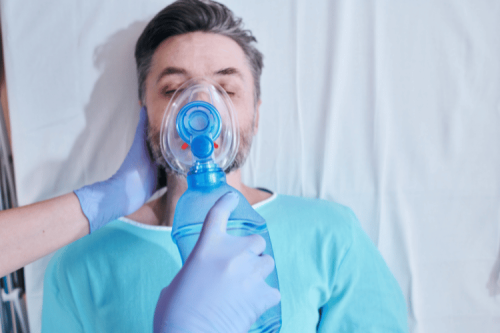
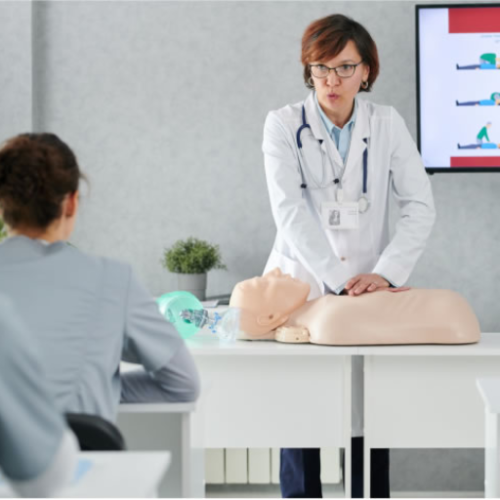
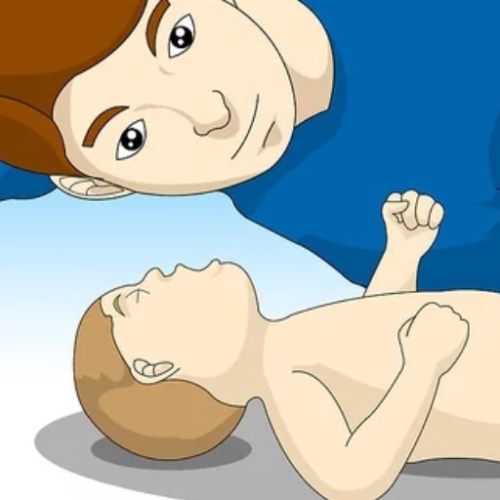


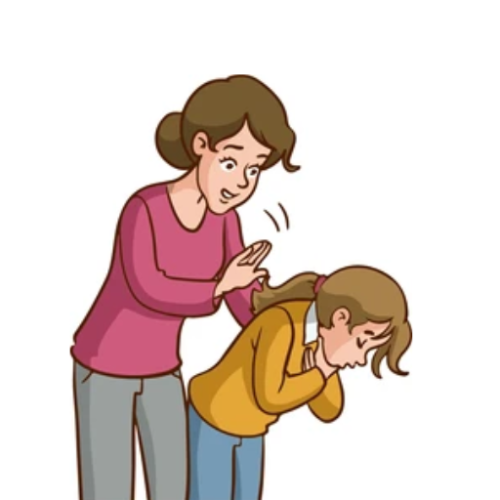
 Login with Google
Login with Google Login with Facebook
Login with Facebook